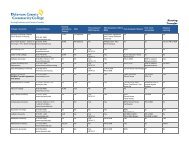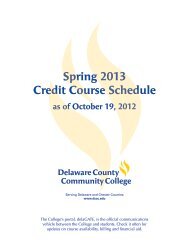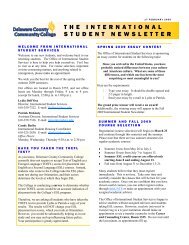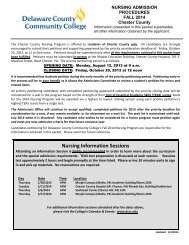2010 Catalog - Delaware County Community College
2010 Catalog - Delaware County Community College
2010 Catalog - Delaware County Community College
Create successful ePaper yourself
Turn your PDF publications into a flip-book with our unique Google optimized e-Paper software.
COURSE DESCRIPTIONS 127<br />
Upon successful completion of this course, students<br />
should be able to:<br />
• Explain heat flow, change-of-state condensing point,<br />
evaporation point and laws of refrigeration.<br />
• Describe the types of commercial refrigeration systems<br />
and identify integral components.<br />
• Cite common problems with expansion valves, pressure<br />
reducing valves, pressure switches, filters and dryers.<br />
• Adjust the superheat and sub cooling of a refrigeration<br />
machine for maximum efficiency.<br />
• Depict a psychrometric chart and understand its use in<br />
air conditioning.<br />
• Measure air flow and discuss common problems<br />
associated with air side residential and commercial<br />
air conditioning.<br />
Prereq. HVA 101<br />
2 Credits 1 Weekly Lecture Hours<br />
2 Weekly Laboratory Hours<br />
HVA 104<br />
Practical Math for HVAC<br />
This course introduces basic mathematics for the<br />
HVAC&R student. The course includes whole and mixed<br />
numbers, fractions, decimals, ratio and proportions, basic<br />
trigonometry and Ohm's law of electrical relationships. It<br />
covers direct and computed measure and presents the use<br />
of standard formulas, graphs and graphing. Theories<br />
tested with problems that are directly related to the HVAC<br />
industry. The course is designed to remediate students<br />
with mathematics concepts and prepare them for traditional<br />
college level math courses. Emphasis will be placed on real<br />
practical applications.<br />
Upon successful completion of this course, students<br />
should be able to:<br />
• Solve problems using ratio and proportion.<br />
• Calculate answers using standard HVAC&R formulas.<br />
• Solve triangles using trigonometric ratios and the law of<br />
sines and cosines.<br />
• Construct graphs from raw data and also interpret<br />
graphs.<br />
• Solve applied HVA problems applying the competencies<br />
above.<br />
3 Credits 3 Weekly Lecture Hours<br />
HVA 107<br />
Gas Heating<br />
This course is designed to provide the relevant theory<br />
and skill to remove and install gas or oil heating systems.<br />
The topics of instruction will include but will not be limited<br />
to the basic system sizing selection of equipment recognizing<br />
the venting requirements for a new installation. Steps<br />
to follow for the safe removal of existing equipment will be<br />
discussed. Restate an understanding of NFPA 54 the<br />
NEC codes and the manufacturers installation instructions.<br />
Provides knowledge to perform basic electric wiring for the<br />
installation of heating equipment and how ductwork is<br />
assembled for hot air systems, the piping schematics, and<br />
components for hot water systems will also be presented.<br />
Upon completion of this course, students should be able to:<br />
• Perform a startup and check operation of the equipment.<br />
• Understand basic heat loss calculation.<br />
• Restate the two types of warm air systems.<br />
• Recognize an up flow, and counter flow heater.<br />
• Recognize operating and safety controls.<br />
• Identify the function of each operating and safety control.<br />
• Calculate air combustion.<br />
• Calculate gas pipes.<br />
• Identify NFPA guidelines for venting gas.<br />
3 Credits 3 Weekly Lecture Hours<br />
HVA 108 Duct and Sheet Metal<br />
Fabrication and Installation -<br />
Residential<br />
This course is designed for students who plan a career<br />
in the heating, ventilation, and air conditioning industry.<br />
Topics covered in this course includes, but is not limited to,<br />
safety, duct takeoff, sheet metal calculations, costing,<br />
installation, heat loss/gain and blueprint reading.<br />
Upon successful completion of this course, students<br />
should be ale to:<br />
• Read and use a duct factor chart.<br />
• Utilize a duct take-off form.<br />
• Determine total weight of metal needed for duct.<br />
• Utilize an installation take-off form.<br />
• Identify costing sheet metal duct, duct liner and installation<br />
• Fabricate air and splitter dampers and drivers.<br />
• Cut openings in duct for take-off collars.<br />
• Join duct sections.<br />
• Apply the proper method of duct sealing.<br />
• Apply external duct insulation.<br />
• Utilize tools of the trade.<br />
• Perform an oblique drawing of a duct system.<br />
• Read a blueprint.<br />
• Install grilles, registers, and diffusers.<br />
• Install flexible connectors.<br />
• Identify NFPA-54 guidelines for venting gas-fired appliances.<br />
• Identify NFPA-31 guidelines for venting oil-fired appliances.<br />
• Identify NFPA-58 guidelines for venting<br />
propane/LP-fired appliances.<br />
3 Credits 3 Weekly Lecture Hours<br />
HVA 109<br />
HVAC Troubleshooting<br />
This course presents the sequence of operation in the<br />
troubleshooting of residential air conditioning and gasfired<br />
warm air systems. The materials and lab demonstrations<br />
promote the safe use of electrical, temperature,<br />
and pressure gages to facilitate a system diagnosis and<br />
recommended solution.<br />
Upon successful completion of this course, students<br />
should be able to:<br />
• Collect and analyze data with the owner.<br />
• Use proper tools safely to find problems.<br />
• Operate the HVAC System to verify safe, efficient services.<br />
• Record operating pressures, temperatures, airflow, and<br />
identification numbers.<br />
• Develop a cost-effective plan of action.<br />
• Demonstrate safe working habits<br />
• Troubleshoot flow charts.<br />
• Identify low voltage systems.<br />
• Identify diagram circuits.<br />
• Utilize pressure gauges.<br />
• Utilize electrical meters<br />
• Use combustion analyzer.<br />
• Recognize system hazards.<br />
• Review plan of action with owner.<br />
Prereq. HVA 100, HVA 200, MAT 110<br />
3 Credits 2 Weekly Lecture Hours<br />
2 Weekly Laboratory Hours<br />
HVA 110<br />
Hydronic Heating Systems<br />
This course is an introduction to hydronic hot water<br />
heating. The course is designed to cover residential and<br />
light commercial systems, which involves many different<br />
piping disciplines. Also covered are design and building<br />
techniques of hot water heating systems.<br />
Upon successful completion of this course, students<br />
should be able to:<br />
• Review safety rules.<br />
• Explain the principles of heat transfer.<br />
• Detail boiler design and construction.<br />
• Calculate heat loss/gain.<br />
• Identify various heat distribution systems.<br />
• Cite the different piping designs of hydronic<br />
heating systems.<br />
• Cite the sequence of operation of a gas or oil fired hot<br />
water boiler.<br />
• Cite the sequence of operation of a hydronic heating system.<br />
• Service and replace hot water boilers.<br />
• Service mechanical controls of a hydronic heating system.<br />
• Identify and install appropriate venting.<br />
• Analyze combustion procedures.<br />
Prereq. HVA 112<br />
2 Credits 1 Weekly Lecture Hours<br />
2 Weekly Laboratory Hours<br />
HVA 111 Advanced Duct and Sheet<br />
Metal Fabrication/Installation -<br />
Commercial<br />
This course is designed for students who plan a career<br />
in the HVAC industry. This course covers safety, duct takeoff,<br />
duct support systems, installation techniques, duct<br />
design, sizing and layout, blueprint reading, and venting<br />
of heating appliances.<br />
Upon successful completion of this course, students<br />
should be ale to:<br />
• Read a blueprint.<br />
• Perform oblique drawings of a duct system.<br />
• Know the difference between supply air and return<br />
air duct systems.<br />
• Identify the different types of duct hangers, clamps<br />
and connectors.<br />
• Identify the need for duct reducers.<br />
• Identify various duct sealing techniques.<br />
• Cut a perfect 10-inch diameter hole in a duct.<br />
• Connect various duct fittings.<br />
• Make branch connections.<br />
• Properly install flexible duct.<br />
• Install flexible connectors.<br />
• Perform an air test and balance.<br />
• Apply external duct insulation.<br />
• Apply and repair duct liner.<br />
• Install grilles, registers and diffusers<br />
• Identify NFPA-54 guidelines for venting gas fired<br />
heating appliances.<br />
• Identify NFPA-31 guidelines for venting oil fired<br />
heating appliances.<br />
• Identify NFPA-58 guidelines for venting<br />
propane/LP gas fired appliances.<br />
Prereq. HVA 108<br />
3 Credits 2 Weekly Lecture Hours<br />
2 Weekly Laboratory Hours<br />
HVA 112 Oil Burners and Hydronic<br />
Steam Heating<br />
This course is an introduction to oil burners and<br />
hydronic steam heating. The course covers the history of<br />
oil burners and their technological growth to present day<br />
in residential and light commercial appliances. Also<br />
discussed are petro-leum crude, refinement, and<br />
distillation into light grade fuel oil. This course also<br />
covers techniques in designing and building of steam<br />
heating systems.<br />
Upon successful completion of this course, students<br />
should be able to:<br />
• Explain the differences in fuel oil grades.<br />
• Explain the principles of oil burner combustion.<br />
• Describe fuel pump operation.<br />
• Explain the functions of safety and operating controls;<br />
their purpose and operation.<br />
• Identify the sequences of operation of an oil burner as<br />
related to hydronic steam boilers.<br />
• Identify the venting process of oil-fired appliances.<br />
• Service oil burners.

















